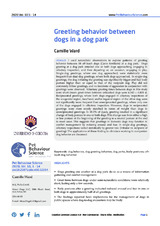Greeting behavior between dogs in a dog park
Autor
Ward, Camille
Editor
Universidad de Córdoba, Departamento de Medicina y Cirugía AnimalFecha
2020Materia
Dog behaviorDog greeting behavior
Dog parks
Body postures
Offleash dog behavior
METS:
Mostrar el registro METSPREMIS:
Mostrar el registro PREMISMetadatos
Mostrar el registro completo del ítemResumen
I used naturalistic observations to explore patterns of greeting behavior between 58 off-leash dogs (Canis familiaris) at a dog park. Dogs greeting at a dog park entailed one or both dogs approaching, engaging in olfactory inspection, and then departing or, on occasion, engaging in play. Single-dog greetings, where one dog approached, were statistically more frequent than dual-dog greetings, where both dogs approached. In single-dog greetings, the dog initiating the greeting was significantly bigger and had body posture higher than or equal to that of the recipient dog. Play did not commonly follow greetings, and no incidents of aggression in conjunction with greetings were observed. Voluntary greeting times between dogs in this study were short (mean greet times between unleashed dogs were 6.042 ± 0.801 s). Reciprocated greetings, where both dogs engaged in olfactory inspections of the anogenital region, face/head, and/or inguinal region of the other dog, were not significantly more frequent than unreciprocated greetings, where only one of the dogs engaged in olfactory inspection. However, dogs in reciprocated greetings were more evenly matched in terms of weight than dogs in unreciprocated greetings. In 48.1% of dyads, greeting resulted in a significant change of body posture in one or both dogs. This change was from either a high or low posture at the beginning of the greeting to a neutral posture at the end in most cases. This suggests that greetings in domestic dogs may function in conflict management by reducing arousal and fear. In single-dog greetings, olfactory inspections varied statistically by greeter role (initiator vs. recipient of greeting). The applications of these finding to clinicians working in companion dog behavior are discussed.

